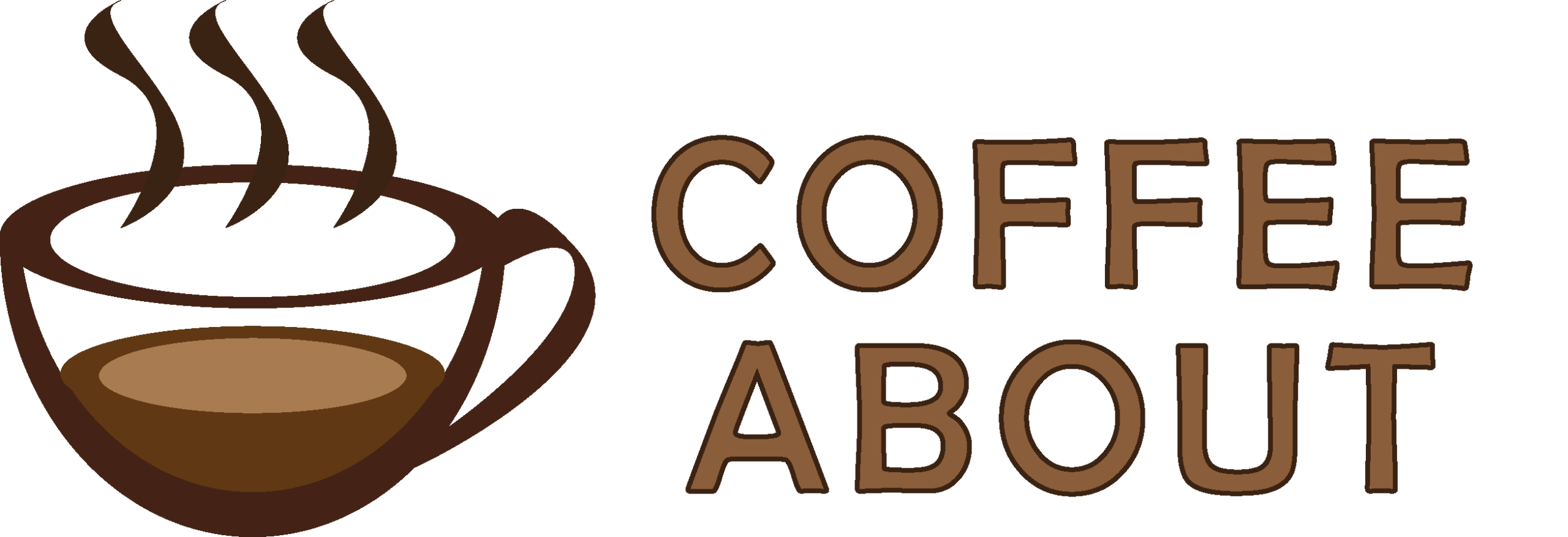Dialing in espresso is a process of tweaking many aspects of the espresso-making procedure, such as the coffee quantity, water ratio, and grind size, until the finished shot satisfies your preferences for taste and quality.
Finding the ideal settings will require some trial and error, but once you do, you’ll be able to recreate that flawless procedure every time.
You need to dial in Espresso every time you change your coffee beans, or upgrade your equipment, like an espresso machine or grinder. It is crucial to dial in the espresso machine regularly to optimize extraction and achieve a balanced flavor.
This article will walk you through the basics of how to dial in Espresso, even if you’re a complete beginner you can start brewing delicious espresso shots at home.
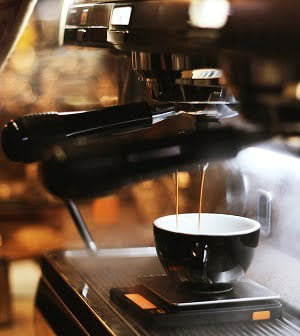
Key takeaways
- Dialing in involves adjusting dose, yield, time, and grind to optimize flavor.
- Start with a 1:2 coffee-to-water ratio (14g coffee for 28g water). Adjust slightly from there.
- Distribute grounds evenly, then tamp firmly and consistently.
- Only change one variable at a time to understand its impact.
- If the shot is too fast (>25sec), grind finer. If too slow (<30sec), grind coarser.
- The dialing-in process takes practice and experimentation but results in consistent, balanced shots.
Espresso Dial in Chart
A dial-in espresso chart is a tool used by baristas and coffee enthusiasts to help guide them through dialing in espresso. The chart typically includes the basics of dialing in process i-e a range of grind sizes, coffee dosages, extraction times, and corresponding taste and texture descriptors.
By using the chart, a barista can begin with a baseline setting and adjust the variables until the resulting shot meets its desired flavor profile.
For example, if a shot is too sour, the barista will try a finer grind, a higher dose, or a longer extraction time to balance the flavors. The chart provides a starting point for experimentation and can help to achieve consistency.
However, it’s important to note that every coffee, machine, and environment is unique, so the chart should be used as a guide rather than a strict set of rules.
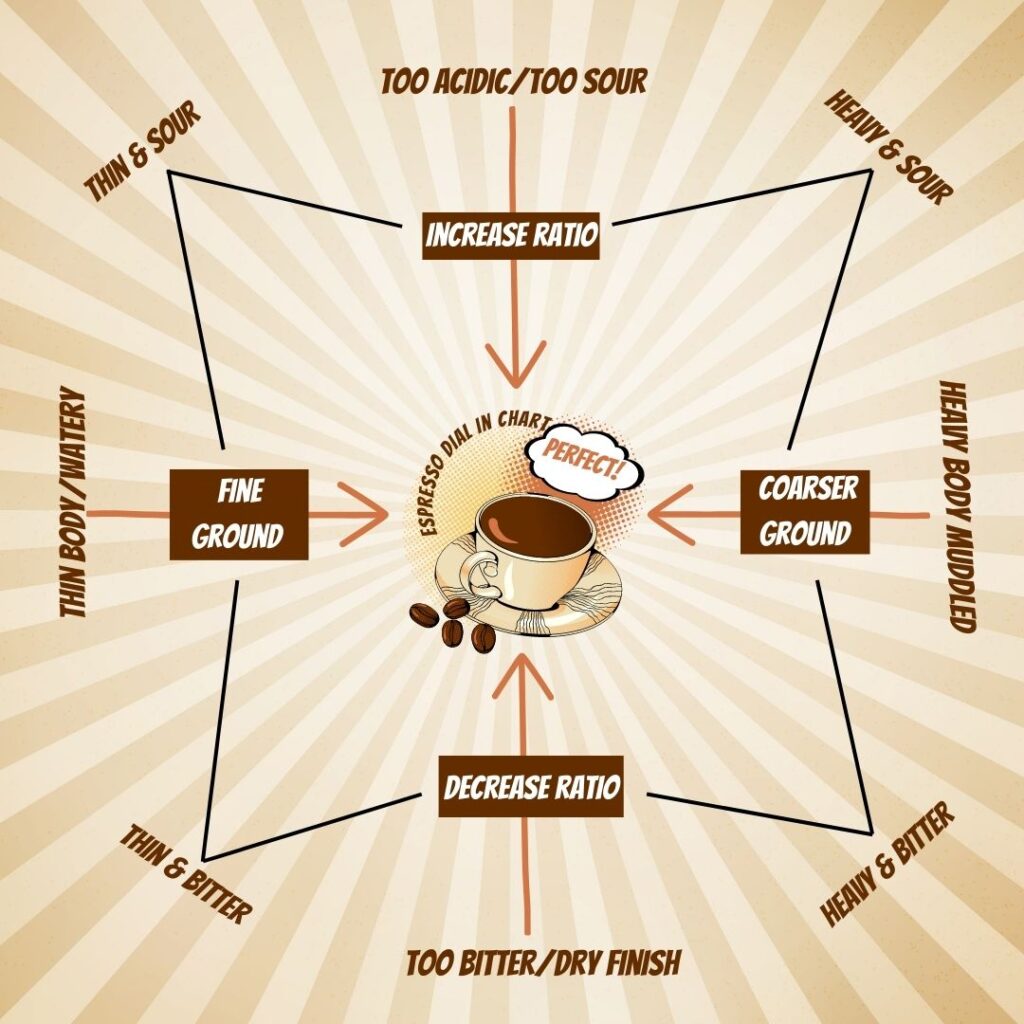
How to Dial in Espresso shot
When Dialing in Espresso, you must only adjust one parameter at a time otherwise you won’t be able to keep track of which one affects the taste and quality of the shot.
Things you need for dialing in Espresso shots
Digital Scale: It is essential to have a digital scale when dialing in espresso shots otherwise you won’t be able to keep track of the yield and dose (And that is very crucial!).
Coffee grinder: You’ll need a good quality burr coffee grinder with multiple grind settings from fine to coarse.
Tamper: You’ll need a tamper which I assume you must have, and a distribution tool. Distribution tool levels of the surface of coffee grounds properly (it’s not a must but preferable).
The dialing in espresso might take around 15 to 30 minutes. This involves making incremental adjustments to factors like grind size and coffee dose while pulling multiple shots and tasting and recording them to determine the optimal settings.
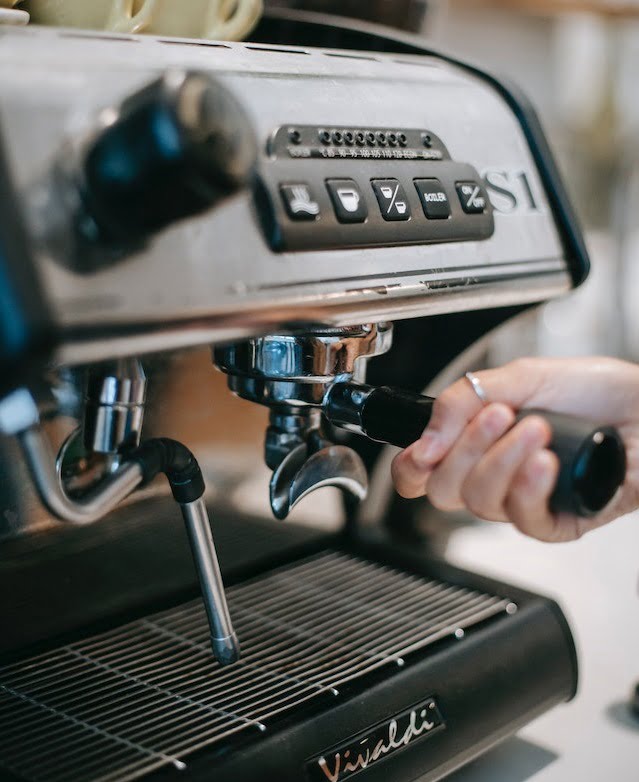
The Dose of coffee grounds
The Dial-in process starts with selecting the right dose of coffee grounds.
For espresso, the ideal coffee-to-water ratio is 1:2. This means that 14 grams of coffee should be used for every 28 grams of water. This is the industry standard, and professional baristas have been using it for decades. It is also known as the 1 2 rule of Espresso.
This ratio yields a strong, flavorful shot of espresso that isn’t too bitter or watery.
However, other factors such as the quality of the roast, and the size of the portafilter also play a role in selecting the right dose.
Size of Portafilter Basket: A Standard double-shot Filter basket is designed to hold around 14-20 grams of coffee. Less or more than that range will affect the pre-infusion of water with grounds that will completely ruin the quality of the shot.
Read a guide on different sizes and types of portafilter baskets
The roast of the beans: Typically dark roasted beans are used for Espresso and if you are using dark roast go with the industry standard of 1:2. When using Medium or Light Roast, you should use fewer grounds since they are less soluble in water and extraction takes longer. I suggest a starting point ratio of 1:2.5 for the medium and light roasts.
Start with 16 grams of coffee for a double shot and make slight adjustments up or down by 0.5 grams until you achieve your desired taste.
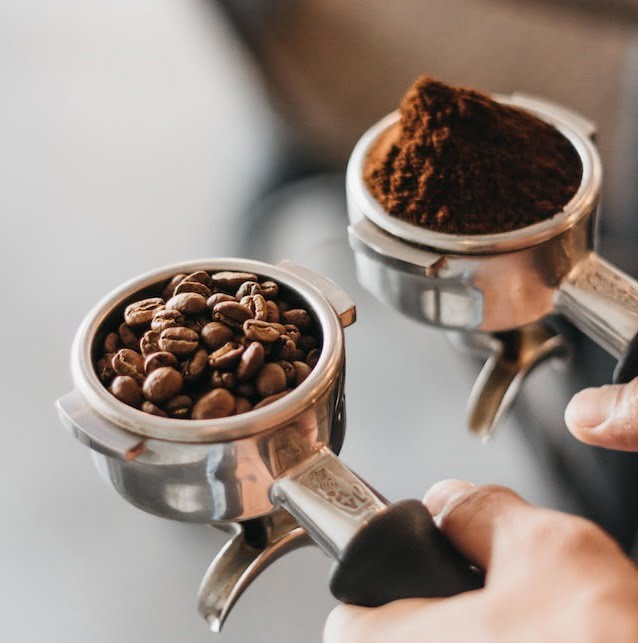
Distributing and tamping the coffee grounds
When making espresso, the way you distribute and tamp the coffee grounds can greatly impact the quality of your shot.
Distributing the grounds evenly helps ensure that the water flows through them uniformly, while tamping ensures the coffee is compacted enough to slow down the water flow and increase the extraction time.
Fill the portafilter basket with coffee and spread the grounds evenly with a distribution tool or you can do it with your finger simply. Apply firm and even pressure to the grounds with a tamper. The goal is to achieve a flat and level surface that is free of air pockets and gaps.
It is critical to tamp the grounds with the proper pressure. Too little pressure will result in a weak and watery espresso shot, whereas too much pressure will result in over-extraction and bitterness.
Don’t overthink the tamping pressure. Just tamp with sufficient force until it pushes back at you and you are done.
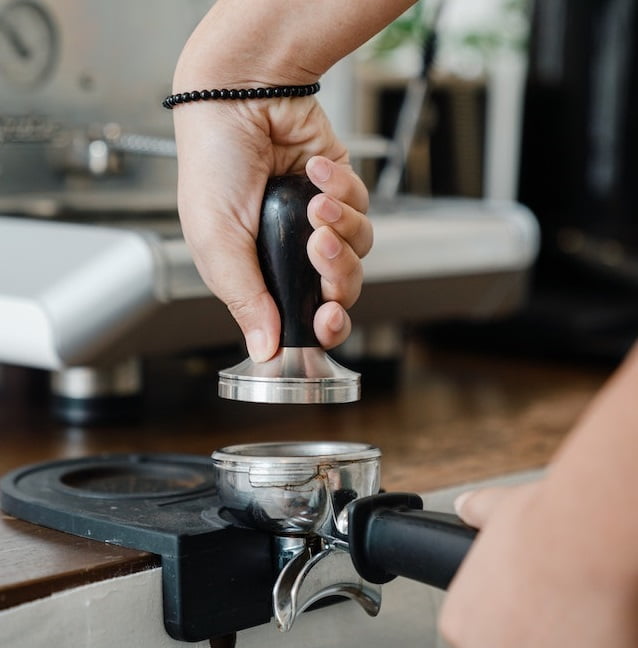
The Final Yield
The final yield is the weight of the final Espresso shot in grams.
As stated earlier, A good starting point for espresso shots is to have a water-to-coffee ratio of 1:2. That means if you are using 16 grams of coffee grounds for a double-shot Espresso your final yield will be around 32 grams.
There are two important things you must understand here.
- If your Espresso yield is high, then more water has passed through the coffee grounds, making your espresso taste bitter or over-extracted.
- If your yield is low, the coffee grounds will remain under-extracted and your drink will lack the full and complex flavors of coffee.
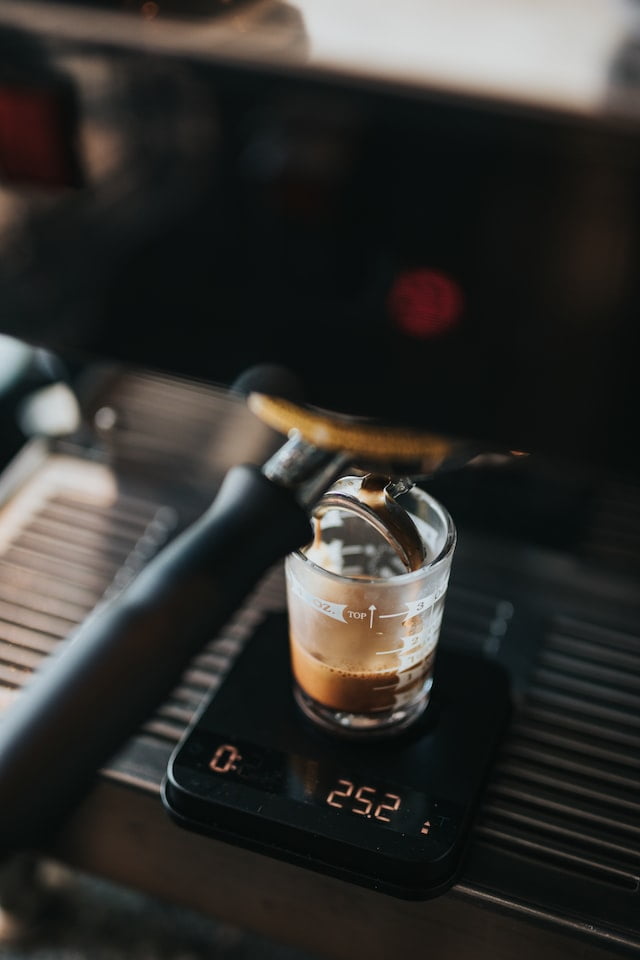
The Grind size and the brewing time
The Grind size is the most important parameter while dialing in Espresso shots. It’s also the most flexible parameter that has a profound effect on the brewing time and the final taste of Espresso.
The coarser the ground, the easier for water to pass through, resulting in a shorter brewing time. On the other hand, the finer the ground, the harder it is for the water to pass through, resulting in a longer brewing time.
The brewing time and grind size are important factors in determining the quality of your shot. In general, a good espresso brewing time is between 25 and 30 seconds.
If you pull your shot too quickly, it will be under-extracted and taste bland. If it pulls too slowly, it will be over-extracted and taste bitter.
According to coffee expert Alexender Mills:
Grind as fine as you can until you perceive astringency (drying sensation in your mouth or unpleasant bitterness) and then dial it back a notch or two. That will be the sweet spot on the grinder for that specific coffee.

The brewing temperature of the water
The ideal brewing temperature for Espresso is 195 to 205 degrees. When the water is at the ideal temperature, it can extract the flavors and aroma from the coffee grounds, resulting in a balanced and rich taste.
The rule of thumb for dialing in the temperature is while using a dark roast start from the lower end at 195 degrees and when using a medium or light roast start from the higher end at 205 degrees.
When adjusting your espresso brewing temperature, make sure to add at least 2 degrees increments in order to experience a noticeable change.
Usually, the temperature is not a big factor as long as it is in the ideal range and most home espresso machines don’t let the users adjust the brewing temperature.
Adjust the temperature only after you have accounted for all the other variables and you are sure it’s the one causing the bad taste.
Read a detailed guide on different types of Espresso machines
Important Factors to Consider While Dialing in Espresso
Here are some important factors you must keep in mind while dialing in Espresso
Only change one parameter at a time: It’s important to change only one parameter at a time whether it’s the dose, yield, or grind size. Otherwise, you will lose track and it will become difficult to measure the results.
Keep a record of the parameters: While Dialing in Espresso it’s always a good practice to keep a record of all the changes you made in some Notepad. This will help you to quickly evaluate how the change in parameters affects the taste of Espresso.
Tamp Properly: Distribute the coffee grounds properly and tamp with the same consistent force every time. Not tamping properly also significantly affects the taste and quality of Espresso.
Final thoughts
I hope this guide has been helpful to you, especially if you’re a beginner looking to improve your espresso-making skills.
Remember, dialing in espresso is all about finding the right balance between the grind size, dose, and extraction time. It will take some trial and error but don’t get discouraged. With practice, patience, and a little bit of experimentation, you’ll be able to make delicious espresso shots that rival those of your favorite coffee shop.
And don’t forget to have fun! Making espresso is an art and a science, and it can be a rewarding and enjoyable experience. So, grab your espresso machine, and your favorite coffee beans, and get dialing!
If you have any questions, please feel free to reach out. I’m always here to help and support you on your espresso-making journey. Cheers!
FAQ
How Should Espresso Taste Like?
A good espresso should have a harmony of sweetness, bitterness, and acidity, It should have a creamy, smooth texture with a rich, lasting crema on top. The specific flavor notes could vary based on the coffee beans used and the brewing conditions.
Why Does The Espresso Have No Crema?
Espresso may not have crema due to several factors, including using old or stale coffee beans, incorrect grind size, or improper tamping.
Using a coarser ground size is the most probable reason for Espresso having no crema.
